The Festival of (In)Appropriation
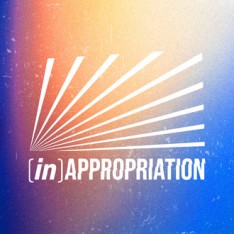
Sunday October 2, 2022, 7:30 pm
Los Angeles Filmforum presents
The Festival of (In)appropriation #12
At 2220 Arts + Archives, 2220 W. Beverly Blvd., Los Angeles CA
In person: Guest Curators Marie-Pierre Burquier, Mariquita “Micki” Davis, and Allyson Unzicker, and filmmakers Misael Oquendo and TT Takemoto
Tickets: $12 general, $5 students/seniors, free for Filmforum members
At https://link.dice.fm/hb0mbm0Ogtb
Masks are still required at Filmforum shows - N95 or KN95.
Collage or compilation. Found footage film or recycled cinema. Remix or détournement. Whatever one might call it, the practice of incorporating preexistent media into new artworks engenders novel juxtapositions, new ideas, and latent connotations… often entirely unrelated to the intentions of the original makers. In that regard, such works are truly “inappropriate.” Indeed, the act of (in)appropriation can reveal unimagined relationships between past and present, here and there, intention and subversion, artist and critic, and perhaps even compel us to reexamine what it means to be the "producer" or "consumer" of visual culture itself.
Fortunately for our purposes, the past decades have witnessed the emergence of countless new kinds of audiovisual material available for artistic (in)appropriation. In addition to official state and commercial archives, resources like vernacular collections, home movie repositories, and digital archives now provide the artist with a wealth of fascinating matter to reprocess, repurpose, and endow with new meaning and resonance.
Founded in 2009 by Jaimie Baron, Greg Cohen, and Lauren Berliner, the Festival of (In)appropriation is a yearly showcase of contemporary, short-form, audiovisual works that appropriate existing film, video, or other media and redeploy them in “inappropriate” and inventive ways. This year marks the culmination of the Festival’s first decade, with a program that ranges from militant political documentary, uncanny TV supercuts, and raucous re-mix juggernauts, to quasi-DIY orphan film animations, haunting YouTube mash-ups oozing with existential teen angst, and a brooding digital experiment performed upon a single, black-and-white, still photograph.
For the first time since its inception, this year’s festival will be guest curated by Marie-Pierre Burquier, Mariquita “Micki” Davis, and Allyson Unzicker.
For more event information: www.lafilmforum.org, or 323-377-7238
Visit the Festival of (In)appropriation at https://festivalofinappropriation.com/
About the Guest Curators:
Marie-Pierre Burquier (Guest Curator) Marie-Pierre Burquier is a PhD candidate in visual studies at Université Paris Cité. She has published papers in several journals such as Hors-Champ, Found Footage Magazine and Transatlantica as well as a chapter in the book Corps béant, corps morcelé dans les arts scéniques et visuels. She has taught several courses dealing with experimental cinema, the transformations of the cinematic apparatus and the relationship between film and medicine. She was a Lecturer in the French Department at University of California, Berkeley, and she is currently a Teaching Assistant in Film Studies at Université Paris Nanterre.
Mariquita “Micki” Davis Mariquita (Guest Curator) “Micki” Davis is a CHamoru artist and educator based in Los Angeles. She is the co-curator of Pasifika Transmissions, a monthly learning series that invites Indigenous artists to visit the archive of the Pacific Island Ethnic Art Museum of Long Beach and develop a video “transmission” of this exchange. Currently she is a programmer for the Los Angeles Asian Pacific Film Festival and mentor for the Armed with a Camera Fellowship program at Visual Communications which champions the films of Asians, Asian Americans, Native Hawai’ians and Pacific Islanders. Her work has been exhibited nationally and internationally, including the Institute of American Indian Arts, Honolulu Biennial, Vancouver Art Gallery, and UNSW Galleries, Museum of Contemporary Native Arts, as well as Yamagata International Documentary Film Festival (YIDFF) and Guam International Film Festival.
Allyson Unzicker (Guest Curator) Allyson Unzicker is a curator and writer from Los Angeles. She has held various curatorial positions at museums and institutions across Southern California, most recently as the Associate Director & Curator of the University Art Galleries at UC Irvine. Her previous work as a curatorial and research assistant includes contributions to seven of The Getty Center’s Pacific Standard Time exhibitions at UCLA’s Chicano Studies Research Center and Fowler Museum, The Watts Towers Arts Center, the Los Angeles Municipal Art Gallery, the Los Angeles County Museum of Art, the Vincent Price Art Museum, and the Frank Lloyd Wright Hollyhock House where she was the project manager and archivist. She has published monographs and essays in a range of exhibition catalogs internationally. Unzicker received her MFA at UC Irvine in Critical & Curatorial Studies with a designated emphasis in Visual Studies and Critical Theory. Currently, she is pursuing a Ph.D. at UC Berkeley in the Film & Media Department.
About the Filmmakers (in person):
Misael José Oquendo (Filmmaker) Misael José Oquendo is a Puerto Rican video artist, curator and writer based in Los Angeles. He recently graduated from the Aesthetics & Politics (2020, MA) program at the California Institute of the Arts. He also studied film and visual critical studies at the School of the Art Institute of Chicago where he graduated with a BFA in 2016. His videos have been exhibited at the Gene Siskel Film Center in Chicago and most recently at the LA Contemporary Archive in Los Angeles.
TT Takemoto is an artist and scholar whose work explores Asian American queer history including the hidden dimensions of same-sex intimacy and queer sexuality for Japanese Americans incarcerated by the US government during World War II. Takemoto was awarded the Grand Jury Prize for Best Experimental Film from Slamdance Film Festival and Best Experimental Film Jury Award at the Austin LGBT International Film Festival. Film screenings include Ann Arbor, Frameline, Outfest, MIX NYC, CAAMfest, Fusion, MIX Milano, Hamburg Queer Film Festival, MIX Mexico, and Rio Gay Film Festival. Takemoto's work has been exhibited and performed at Oakland Museum of California, Chinese Culture Center, Asian Art Museum, Oceanside Museum ofArt, GLBT History Museum, New Conservatory Theatre, Sabina Lee Gallery, Sesnon Gallery, SF Camerawork, SOMArts, SFMOMA, and Vargas Museum.
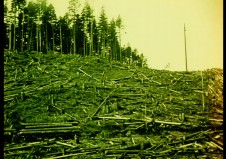
Persistence & Loss by Joseph Clark
Persistence & Loss
By Joseph Clark
Canada, English, 35mm archival & 16mm archival, b/w and color, sound, 2021, 2:49.
World premiere!
With Persistence and Loss, Joseph Clark makes the spectator think about film, memory and deforestation. Still images of trees being cut in British Columbia are flickering on the screen while a voice over gives a lecture about what makes movies possible and the way human eyes perceive movement.
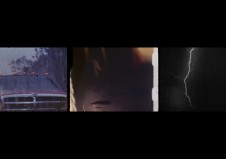
The following images never happened by Noé Grenier
The following images never happened
By Noé Grenier
France, 2022, English, 16 mm on digital, color, sound, 7:12. US Premiere!
In 1996, a screening of the American action film Twister by Jan de Bont, initially scheduled at the Can-View Drive-in in southern Canada was canceled due to a tornado warning. Throughout The Following Images Never Happened, French artist Noé Grenier gathers fragments from the film’s trailer that strangely appear to be physically marked by the wind and scratched by the heavy rain. Dividing the screen into three parts, he gives shape to the imaginative visions some spectators had after thinking they actually attended the screening in the middle of the storm.

Al Atlal (The Ruins) by Raed Rafei
Al Atlal (The Ruins)
By Raed Rafei
Lebanon, 2021, Arabic & English, English subtitles, digital video, color, sound, 15:37.
West Coast Premiere!
Al-Atlal (The Ruins) reflects upon the paradoxes of queer histories where homosexuality is both celebrated and condemned. Exploring the complex relations between the histories of intimacy and empire, the film engages with the fragmented nature of archives as a digital ruin. A vision of an ancient, empty Hammam is juxtaposed with various images appropriated from visual culture, news footage, and Egyptian cinema, the physical and digital ruins are recontextualized together linking various histories of gay saunas from East to West. Through these disparate sources, the film engenders harmonies, frictions, and tensions where the site of architecture and bodies converge as an evocative site of pleasure and pain.
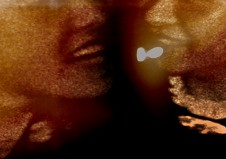
On the Line by TT Takemoto
On the Line
By TT Takemoto
United States, 2018, digital video & 16mm, color, sound, 6:40.
LA Premiere!
A soundscape of sloshing waves, seabirds and slicing knives sets the backdrop for a mirage of hidden desires. Close-up shots of women smiling are juxtaposed with hands sensuously kneading dough to violently cleaning and slicing tuna along an assembly line. Bouncing between warm and cool tones, this abstract blend of found footage scenery of prewar cannery workers in San Diego functions as a queer meditation on the Japanese American women who engaged in same sex intimacy while the men were off at sea.
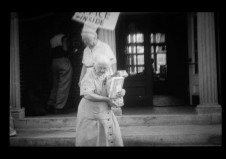
How the dead live by Marcelo Amorim
How the dead live
By Marcelo Amorim
Brazil, 2018, Portuguese, English subtitles, digital video, b/w, sound, 3:22.
World premiere!
We old women are easily erased from the picture of the last century. [...] Where are we all gone? Brazilian actress Iara Jamra embodies the voice of a woman who interrogates herself from the afterlife about the underrepresentation of women in images of History. Her childish interpretation of an excerpt of the book How the dead live (by Will Self) is coupled with black and white home movies, old commercials and film magazines that show women cleaning, working in factories or babysitting. By appropriating images that are now available on the internet, Brazilian artist Marcelo Amorim creates an uncanny picture that denounces the visible absence of women in history.
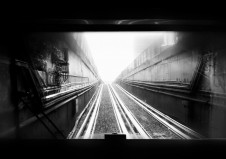
Ouroboros by Antonio Arango Vásquez
Ouroboros
By Antonio Arango Vásquez
Mexico, 2018, Spanish, English subtitles, digital video & 16mm film archive, b/w, sound, 8:44.
US Premiere!
Experimental film essay about the student massacre that happened in Mexico in 1968 with a dialogue surrounding the events of missing students in Ayotzinapa, Mexico. From Nietzsche's texts about the Eternal Return (present in Thus Spoke Zarathustra and especially in the essay The Gay Science) the film project reflects on the History and the injustices that took place in Mexico (October 1968). These events keep repeating and manifesting themselves in one way or another. History marks us and points out events with a distance as an unrepeatable past that has no relation to our present. It is from a philosophical point of view that we reflect on what this means.

JUST LIKE THE FILMS by Sara N. Santos
JUST LIKE THE FILMS
By Sara N. Santos
Portugal, 2020, English, digital video, b/w, sound, 10:00.
US Premiere!
Just Like the Films is a portrait of a man entirely made out of 1940s Hollywood film noir excerpts. Through an intimate voice-over and thanks to the re-edition of the excerpts’ original sound, Portuguese artist Sara N. Santos creates an intimate archive of her deceased grandfather with black and white images from her personal cinephile filmography. Focusing her attention on specific details and unremarkable fragments, she exposes how fictional material can acquire a therapeutic value in the process of mourning and remembering.

two sisters, by Magdalena Bermudez
two sisters
By Magdalena Bermudez
United States, 2021, English, digital video, color, sound, 7:46.
West Coast Premiere!
A history of sister portraiture is reanimated by nascent datasets, as portraits dodge derogatory categories by paradoxically inhabiting one and multiple bodies. Two Sisters is a delightfully uncanny film telling of itself.
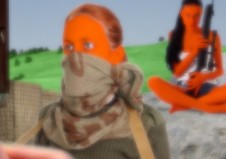
Dandelions in Virginia, by Misael Oquendo
Dandelions in Virginia
By Misael Oquendo
United States, 2022, English, digital video, color, sound, 5:29.
World premiere!
Dandelions in Virginia explores the skewed narratives of conspiracy fantasies and myths through the utilization of deep neural net A.I. motion capture applications, found footage, and stock imagery. Drawing upon obscure subcultures and peculiar narratives, the artifice of motion capture is emphasized through image infidelity where the peculiarities of the digital and the human converge through the uncanny. Dandelions explores the paradoxes of isolation, the hegemonies of consumer culture, and the incoherencies of conspiracies as they converge between digital networks and reality.

The Footprint of Freedom, by Tom Rosenberg
The Footprint of Freedom
By Tom Rosenberg
United States, 2021, French & English, English subtitles, digital video, color, sound, 11:00.
World Premiere!
In the 1970s the Chagos Islanders, or Ilois, were forcibly removed from their archipelago homelands in the Indian Ocean to make way for a US naval base. The Footprint of Freedom is part statement about the American empire in the 21st century and reflection on social media’s role as an archive of empire, diaspora and collective trauma.

Cinema as Ritual, by Darren Wallace
Cinema as Ritual
By Darren Wallace
United States, 2020, English, digital video, color, sound, 3:16.
West Coast premiere!
Cinema as Ritual is a techno-shamanic altar engaging Digital Anthropophagy to process the social iniquities of life in the U.S. during 2020 (Covid-19, West Coast wildfires, anti-Black state violence). It is intended to be experienced as an ecstatic purge or shamanic cleanse stirring audience members desensitized by the longue durée of colonial violence. The triptych structure of the film ushers the audience through shamanic initiation cycles of Death, Liminal Space, and Rebirth.
